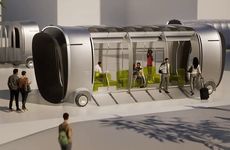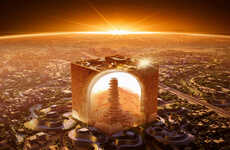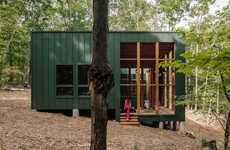The unearthly architecture that you're seeing in these images represent a master plan for a new type of metropolis. The DUNElab proposal involves artificially intelligent technology from the first stages of surveying to the final stages of construction as an apparently paradoxical way to learn from nature's shapes and fluctuations.
The initial desert dune field would be analyzed by mobile robots in order to better understand the changes in the sand, rock and any vegetation. Seemingly abstract forms are then actually printed to enclose a system of interior spaces. Like the veins of a leaf, the mass's skeleton branches out to occupy more horizontal area. Translucent sheets provide shelter from the elements in Timothee Raison, Asa Darmatriaji and Olga Kovrikova's DUNElab concept.
Cellular Desert Cities
The DUNElab Project Anticipates a Futuristic Societal Infrastructure
Trend Themes
1. Artificially Intelligent Technology - Opportunity for incorporating AI technology from surveying to construction in infrastructure projects.
2. Nature-inspired Design - Exploring the use of natural shapes and fluctuations in architectural design.
3. Translucent Shelter Structures - Innovative use of translucent sheets to provide shelter in unconventional architectural projects.
Industry Implications
1. Architecture and Construction - Adopting AI technology and nature-inspired design principles in building urban infrastructure.
2. Robotics and Automation - Developing mobile robots for analyzing desert environments and assisting in construction processes.
3. Material and Building Technologies - Advancing the use of translucent materials in creating innovative structures for shelter and infrastructure.






